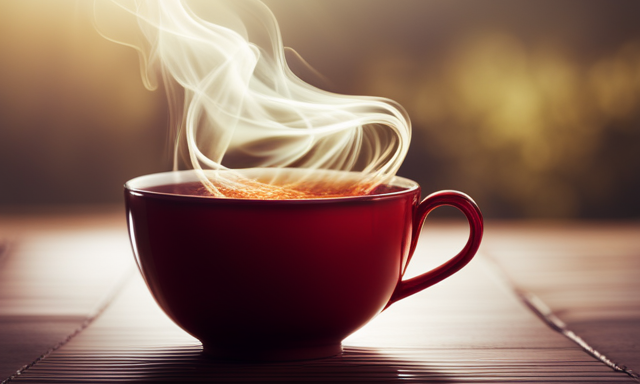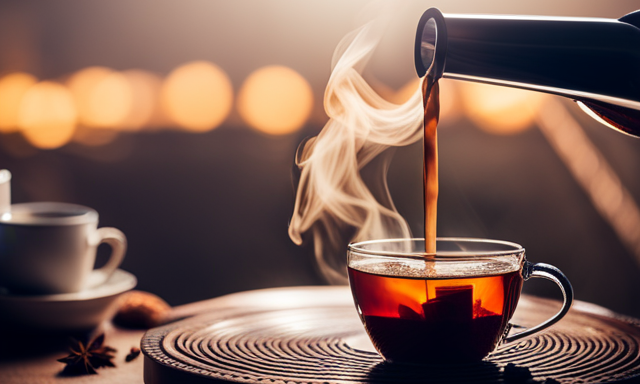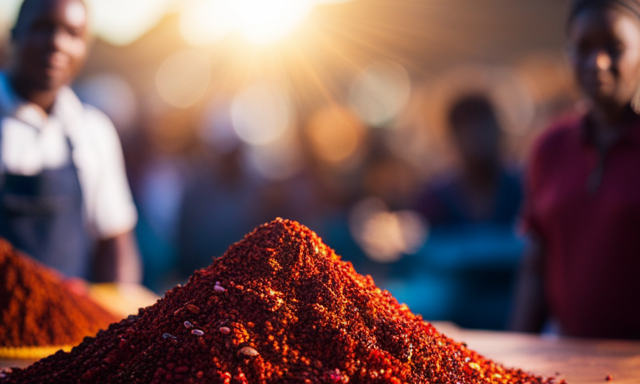As I sit down to enjoy a cup of soothing rooibos tea, the fragrant aroma wafts through the air, instantly calming my senses. There’s something truly magical about this South African herbal tea that has captured the hearts of tea enthusiasts around the world. But, when it comes to brewing the perfect cup, one question often arises: how much rooibos tea should I use per cup?
In this article, I will guide you through the art of achieving the ideal tea-to-water ratio for your desired strength and flavor. Whether you prefer a strong and robust brew or a subtle and delicate taste, experimenting with different ratios will help you discover your personal preference.
Additionally, I will share tips on measuring tea using both tea bags and loose leaf tea, as well as brewing techniques, such as steeping time and water temperature. So, grab your favorite teacup and join me on this journey to unlock the full potential of your rooibos tea experience.
Key Takeaways
- The ideal tea-to-water ratio for rooibos tea is 1 teaspoon of loose tea per cup.
- Experiment with different ratios to find your preferred strength and flavor.
- Adjusting the amount of tea used can create a stronger or more delicate taste.
- Rooibos tea can be steeped for 5-7 minutes in boiling water at a temperature of 212°F (100°C).
Understanding Rooibos Tea: A Brief Introduction
If you want to fully immerse yourself in the calming and earthy flavors of rooibos tea, you’ll need to steep about one teaspoon of loose leaves per cup.
Rooibos tea, also known as red tea or bush tea, is a caffeine-free herbal infusion that originates from South Africa. It is renowned for its numerous health benefits, including its high antioxidant content and potential to support digestion and relieve allergies.
To brew a perfect cup of rooibos tea, you can use various methods such as steeping the leaves in hot water for about 5-7 minutes or using a teapot and strainer. The key is to find the brewing method that suits your preferences.
The right tea-to-water ratio is crucial to achieving the desired flavor and strength, which we will explore in the subsequent section about the importance of the right tea-to-water ratio.
The Importance of the Right Tea-to-Water Ratio
Achieving the perfect balance of tea and water can truly elevate your tea-drinking experience. The right tea-to-water ratio is crucial in determining the strength of your rooibos tea. Too much water can result in a weak and flavorless brew, while too much tea can make it overpowering and bitter.
To find the ideal ratio, consider experimenting with different brewing methods. Here are two sub-lists to guide you:
-
Traditional Method:
- Use 1 teaspoon of loose rooibos tea per cup of hot water.
- Steep for 5-7 minutes for a robust flavor.
-
Concentrated Method:
- Double the amount of tea to 2 teaspoons for a stronger brew.
- Steep for a shorter duration, around 3-4 minutes.
Determining your preferred strength: experimenting with different ratios allows you to customize your tea to suit your taste. Transitioning into the subsequent section, you can further explore how to achieve your desired tea strength through various methods.
Determining Your Preferred Strength: Experiment with Different Ratios
Discovering your preferred strength is as simple as experimenting with different ratios, allowing you to tailor your tea to your unique taste preferences and evoke a delightful sense of satisfaction. By adjusting the amount of rooibos tea in each cup, you can find the perfect balance of flavor and strength that suits you best.
Start by using a standard ratio of one teaspoon of tea per cup of water and gradually increase or decrease the amount to find your desired taste. If you prefer a lighter and milder cup, try using slightly less tea, while those who enjoy a stronger and more robust flavor can use a little more tea. This trial and error process will help you find the ideal strength that satisfies your cravings for a comforting and flavorful cup of rooibos tea.
Transitioning into the subsequent section about a strong and robust cup: using more tea for a bolder flavor, you can explore the next level of intensity.
A Strong and Robust Cup: Using More Tea for a Bolder Flavor
To create a bold and robust cup of rooibos, simply increase the amount of tea used in each brew. By using more tea leaves, you can achieve a bolder taste that is full-bodied and satisfying.
When steeping your rooibos tea, it’s important to consider the steeping techniques that will ensure a stronger flavor. Firstly, make sure to use boiling water to release the full potential of the tea leaves. Secondly, extend the steeping time by a few minutes to allow the flavors to fully infuse into the water. This will result in a more intense and robust cup of rooibos tea.
Transitioning into the subsequent section about achieving a subtle and delicate taste: using less tea for a lighter brew, it’s important to note that by adjusting the amount of tea leaves used, you can achieve different flavor profiles to suit your preference.
Achieving a Subtle and Delicate Taste: Using Less Tea for a Lighter Brew
For a lighter brew, simply use fewer tea leaves and allow them to steep for a shorter amount of time, resulting in a subtle and delicate flavor that will leave you wanting more. To achieve this, follow these steps:
- Use approximately half the amount of tea leaves you would normally use for a regular cup.
- Steep the tea for only 3-4 minutes instead of the usual 5-7 minutes.
- Be mindful of the water temperature, as a lower temperature will also contribute to a lighter brew.
By using less tea and reducing the steeping time, you can create a brew that is milder in taste and has a lighter color. This method allows the subtle notes of the rooibos tea to shine through, making it perfect for those who prefer a more delicate flavor. However, keep in mind that the ideal tea strength is subjective and can vary depending on the quality of the tea and personal preference.
Factors that Affect the Ideal Ratio: Tea Quality and Personal Preference
When it comes to finding your ideal tea strength, factors such as the quality of the tea and your personal preference play a crucial role. The quality of the tea leaves will determine the flavor profile and intensity of your brew. Higher quality rooibos tea will generally have a more robust and full-bodied taste, while lower quality tea may be milder and less flavorful.
Additionally, your personal taste preference will also influence the ideal ratio. Some people prefer a stronger and more concentrated brew, while others enjoy a lighter and more delicate taste. Experimenting with different amounts of tea in your brew can help you find the perfect balance that suits your palate.
Moving on to tips for measuring tea: using tea bags vs loose leaf tea, there are a few key considerations to keep in mind.
Tips for Measuring Tea: Using Tea Bags vs Loose Leaf Tea
When it comes to measuring tea, accuracy is key to achieving the perfect cup. One of the factors that can affect the ideal ratio is the type of tea used. Both loose leaf tea and tea bags have their own pros and cons.
While tea bags offer convenience and ease of use, they may not provide the same level of flavor and aroma as loose leaf tea. Measuring loose leaf tea allows for more control over the strength and taste of the tea. Additionally, loose leaf tea is often of higher quality, as it’s made from whole tea leaves rather than broken leaves found in tea bags. This results in a more robust and flavorful cup of tea. So, if you’re looking for the most accurate and flavorful cup, consider using loose leaf tea.
Now, let’s move on to brewing techniques: steeping time and water temperature.
Brewing Techniques: Steeping Time and Water Temperature
To get the best flavor from your tea, it’s important to consider the amount of time you let it steep and the temperature of the water. When brewing rooibos tea, the ideal steeping time is 5-7 minutes. This allows the tea leaves to fully infuse in the water, resulting in a rich and flavorful cup.
As for water temperature, rooibos tea should be brewed with water that’s heated to a rolling boil, around 212°F (100°C). This higher temperature helps to extract the full range of flavors from the tea leaves.
To ensure the perfect cup of rooibos tea, follow these brewing techniques:
- Use 1 teaspoon of loose leaf rooibos tea per cup of water.
- Steep the tea leaves for the recommended 5-7 minutes.
- Brew with water that’s heated to a rolling boil.
By mastering the brewing time and water temperature, you can savor the full potential of your rooibos tea.
Now, let’s explore how to enhance your rooibos tea experience by adding sweeteners or milk.
Enhancing Your Rooibos Tea Experience: Adding Sweeteners or Milk
When it comes to enhancing your rooibos tea experience, there are a few options to consider. Adding sweeteners is a popular choice for those who prefer a sweeter taste. Common sweetener options include honey, sugar, or stevia. Keep in mind that rooibos tea already has a naturally sweet flavor, so it’s best to start with a small amount of sweetener and adjust to your preference. Additionally, if you enjoy a creamy texture in your tea, you may want to try adding alternative milk options such as almond milk, oat milk, or coconut milk. These milk alternatives can complement the earthy and nutty flavors of rooibos tea. Experimenting with different sweeteners and milk options can truly elevate your rooibos tea experience. Now, let’s explore variations: rooibos tea blends and flavor infusions.
Exploring Variations: Rooibos Tea Blends and Flavor Infusions
Discovering the world of rooibos tea blends and flavor infusions can add a delightful twist to your tea experience. Here are three exciting variations to explore:
-
Rooibos Tea Recipes: Experiment with different ingredients to create unique rooibos tea recipes. Try adding fresh fruits like berries or citrus slices for a burst of flavor. You can also infuse your tea with herbs like mint or chamomile to create a soothing blend. Get creative and mix and match flavors to find your perfect combination.
-
Health Benefits of Rooibos Tea: Rooibos tea isn’t just delicious but also packed with health benefits. It’s rich in antioxidants, which help protect the body against free radicals. Rooibos tea is also caffeine-free and low in tannins, making it a great choice for those looking for a soothing drink without the jitters. Additionally, it may help improve digestion and support a healthy immune system.
-
Flavor Infusions: Enhance the natural taste of rooibos tea by infusing it with different flavors. Add a splash of vanilla extract or a sprinkle of cinnamon for a warm and comforting twist. For a refreshing option, try infusing your tea with sliced cucumber or a hint of lemon juice. The possibilities are endless, so don’t be afraid to experiment and find your favorite flavor combination.
Overall, exploring rooibos tea blends and flavor infusions allows you to personalize your tea experience while enjoying the numerous health benefits this delightful beverage has to offer.
Frequently Asked Questions
Can I reuse the tea leaves for a second cup of rooibos tea?
Yes, you can reuse rooibos tea leaves for a second cup. Not only does this save money, but it also helps maximize the health benefits of rooibos tea, which include boosting immunity and improving digestion.
What is the best type of water to use when brewing rooibos tea?
The best temperature for brewing rooibos tea is 200°F. Using filtered water has the benefits of removing impurities and enhancing the tea’s natural flavors.
Can I mix rooibos tea with other types of tea?
Sure, you can totally mix rooibos tea with other herbal blends for a unique flavor experience. Combining rooibos with green tea can enhance its health benefits, creating a delicious and nutritious drink.
How long should I steep rooibos tea for maximum flavor?
To maximize the flavor of rooibos tea, steep it for 5-7 minutes. This allows the natural sweetness and earthy notes to fully develop. Additionally, rooibos tea has benefits for the skin, promoting a healthy complexion.
Can I drink rooibos tea before bed without it affecting my sleep?
Sure, you can drink caffeine-free rooibos tea before bed without it affecting your sleep. Unlike caffeinated teas, rooibos tea is known for its calming properties, which can promote relaxation and a good night’s sleep.
Conclusion
After delving into the world of Rooibos tea, one thing’s clear: the right tea-to-water ratio is crucial for a perfect cup. Experimenting with different ratios allows you to discover your preferred strength, whether it’s a bold and robust flavor or a lighter and delicate brew. Don’t underestimate the impact of measuring tea accurately, whether using tea bags or loose leaf tea.
And don’t forget to pay attention to steeping time and water temperature for the best results. With Rooibos tea, the possibilities are endless, so go ahead and enhance your experience with sweeteners, milk, or even explore different blends and flavor infusions. Cheers to a truly exceptional cup of Rooibos tea!










